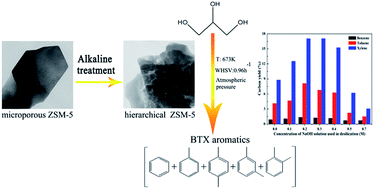Performance of hierarchical HZSM-5 zeolites prepared by NaOH treatments in the aromatization of glycerol
Abstract
A series of hierarchical HZSM-5 zeolites were prepared by post-synthesis modification of conventional bulk crystals of HZSM-5 zeolite with sodium hydroxide (NaOH) solution at different concentrations. These micro–mesoporous composite molecular sieves were characterized by powder X-ray diffraction, transmission electron microscopy, nitrogen adsorption, Fourier transform infrared (FT-IR) spectroscopy techniques and pyridine FT-IR to investigate the changes in crystallinity, acidity, morphology and textural property of HZSM-5 zeolite before and after alkaline treatment. The catalytic performances of these hierarchical HZSM-5 zeolites were evaluated by the aromatization of glycerol with methanol as the solvent, which was a promising route for converting renewable glycerol and methanol into high value aromatics. Substantial mesoporosity with sizes centered at around 4 nm could be generated for HZSM-5 zeolites after treatment with mild NaOH solution (≤0.4 M), coupled with improved retained microporosity, resulting in great improvements in catalytic lifetime and selectivity to benzene, toluene and xylene (BTX) aromatics during the reaction of glycerol to aromatics. Although the larger mesopore surface areas were achieved when treated with NaOH concentrations that were higher than 0.5 M, the HZSM-5 structure was partly damaged, leading to the reduction of catalytic lifetime and selectivity to BTX aromatics. The HZSM-5 treated with 0.3 M NaOH solution was found to be the optimum catalyst for the transformation of glycerol/methanol to aromatics, producing a nearly two-fold increase in BTX aromatics (carbon yields of 25.18%) and three-fold improvement in catalyst lifetime (12.5 h) when compared to the parent microporous HZSM-5 (13.9% carbon yields of BTX aromatics and catalyst lifetime of 4 h). These improved catalytic performances are mainly attributed to the optimized bimodal micro–mesoporous HZSM-5 zeolite during the alkali treatment, which retained sufficient micropores that have the capacity for aromatization and also more mesopores were created that would shorten the average diffusion path lengths, increase the accessibility to the acid sites and facilitate the transportation of large molecules, e.g., glycerol and carbon precursors, during the aromatization of glycerol.


 Please wait while we load your content...
Please wait while we load your content...